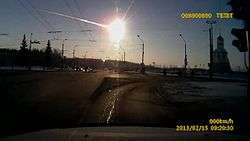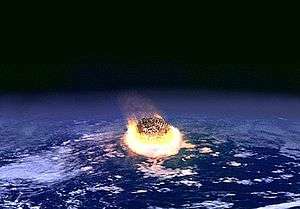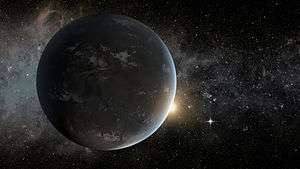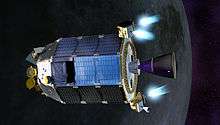Chelyabinsk meteor
|
(image link) Meteor fireball seen from Kamensk-Uralsky where it was still dawn, in an oblast north of Chelyabinsk  | |
| Time | 09:20 YEKT (UTC+06:00) |
|---|---|
| Date | 15 February 2013 |
| Location | |
| Coordinates | 55°09′00″N 61°24′36″E / 55.150°N 61.410°ECoordinates: 55°09′00″N 61°24′36″E / 55.150°N 61.410°E[1] |
| Also known as | Chelyabinsk meteorite[2] |
| Cause | Meteor air burst |
| Non-fatal injuries | 1,491[3] |
| Property damage | Over 7,200[4] damaged buildings, collapsed factory roof, shattered windows |
The Chelyabinsk meteor was a superbolide caused by a near-Earth asteroid that entered Earth's atmosphere over Russia on 15 February 2013 at about 09:20 YEKT (03:20 UTC), with a speed of 19.16 ± 0.15 kilometres per second (60,000[5]–69,000 km/h or 40,000[5]–42,900 mph).[6][7] It quickly became a brilliant superbolide meteor over the southern Ural region. The light from the meteor was brighter than the Sun, visible up to 100 km away. It was observed over a wide area of the region and in neighbouring republics. Some eyewitnesses also felt intense heat from the fireball.
On account of its high velocity and shallow angle of atmospheric entry, the object exploded in an air burst over Chelyabinsk Oblast, at a height of around 29.7 km (18.4 miles, 97,400 feet).[7][8] The explosion generated a bright flash, producing a hot cloud of dust and gas that penetrated to 26.2 km, and many surviving small fragmentary meteorites, as well as a large shock wave. The bulk of the object's energy was absorbed by the atmosphere, with a total kinetic energy before atmospheric impact equivalent to approximately 500 kilotons of TNT (about 1.8 PJ), about 29 times the energy released from the atomic bomb detonated at Hiroshima.
The object was undetected before its atmospheric entry, in part because its radiant was close to the Sun. Its explosion created panic among local residents, and about 1,500 people were injured seriously enough to seek medical treatment. All of the injuries were due to indirect effects rather than the meteor itself, mainly from broken glass from windows that were blown in when the shock wave arrived, minutes after the superbolide's flash. Some 7,200 buildings in six cities across the region were damaged by the explosion's shock wave, and authorities scrambled to help repair the structures in sub-zero (°C) temperatures.
With an estimated initial mass of about 12,000–13,000 metric tonnes[7][8][9] (13,000–14,000 short tons, heavier than the Eiffel Tower), and measuring about 20 metres in diameter, it is the largest known natural object to have entered Earth's atmosphere since the 1908 Tunguska event, which destroyed a wide, remote, forested area of Siberia. The Chelyabinsk meteor is also the only meteor confirmed to have resulted in a large number of injuries. No deaths were reported.
The earlier-predicted close approach of another, larger asteroid that same day, the roughly 30-metre 367943 Duende (at the time still known by its provisional designation 2012 DA14) occurred about 16 hours later; the very different orbits of the two objects showed they were unrelated to each other.
Initial reports
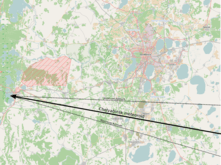
Local residents witnessed extremely bright burning objects in the sky in Chelyabinsk, Kurgan, Sverdlovsk, Tyumen, and Orenburg Oblasts, the Republic of Bashkortostan, and in neighbouring regions in Kazakhstan,[10][11][12] when the asteroid entered the Earth's atmosphere over Russia.[13][14][15][16][17] Amateur videos showed a fireball streaking across the sky and a loud boom several minutes afterwards.[18][19][20] Some eyewitnesses also felt intense heat from the fireball.[21]
The event began at 09:20:21 Yekaterinburg time,[7][8] several minutes after sunrise in Chelyabinsk, and minutes before sunrise in Yekaterinburg. According to eyewitnesses, the bolide appeared brighter than the sun,[11] as was later confirmed by NASA.[22] An image of the object was also taken shortly after it entered the atmosphere by the weather satellite Meteosat 9.[23] Witnesses in Chelyabinsk said that the air of the city smelled like "gunpowder",[23] "sulfur" and "burning odors" starting about 1 hour after the fireball and lasting all day.[8]
Atmospheric entry
_-_Meteorite.gif)
The visible phenomenon due to the passage of an asteroid or meteoroid through the atmosphere is called a meteor.[24] If the object reaches the ground, then it is called a meteorite. During the Chelyabinsk meteoroid's traversal, there was a bright object trailing smoke, then an air burst (explosion) that caused a powerful blast wave, the cause of the damage to thousands of buildings in Chelyabinsk and its neighbouring towns. The fragments entered dark flight (without the emission of light) and created a strewn field of numerous meteorites on the snow-covered ground (officially named Chelyabinsk meteorites).
The last time a similar phenomenon was observed in the Chelyabinsk region was the Kunashak meteor shower of 1949, after which scientists recovered about 20 meteorites weighing over 200 kg in total.[25] The Chelyabinsk meteor is thought to be the biggest natural space object to enter Earth's atmosphere since the 1908 Tunguska event,[26][27][28] and the only one confirmed to have resulted in a large number of injuries,[29][Note 1] although a small number of panic-related injuries occurred during the Great Madrid Meteor Event of 10 February 1896.[30]
According to the Russian Federal Space Agency, preliminary estimates indicated the object was an asteroid moving at about 30 km/s in a "low trajectory" when it entered Earth's atmosphere. According to the Russian Academy of Sciences, the meteor then pushed through the atmosphere at a velocity of 15 km/s.[16][23][31] The radiant (the apparent position of origin of the meteor in the sky) appears from video recordings to have been above and to the left of the rising Sun.[32]
Early analysis of CCTV and dashcam video posted online indicated that the meteor approached from east by south, and exploded about 40 km south of central Chelyabinsk above Korkino at a height of 23.3 km (14.5 miles, 76,000 feet), with fragments continuing in the direction of Lake Chebarkul.[1][33][34][35] On 1 March 2013 NASA published a detailed synopsis of the event, stating that at peak brightness (at 09:20:33 local time), the meteor was 23.3 km (14.5 miles, 76,000 feet) high, located at 54.8°N, 61.1°E. At that time it was travelling at about 18.6 km/s (11.6 mi/s), (about 67,000 km/h, or about 41,750 mph) —almost 60 times the speed of sound.[1][36] In November 2013, results were published based on a more careful calibration of dash cam videos in the field weeks after the event during a Russian Academy of Sciences field study, which put the point of peak brightness at 29.7 km altitude and the final disruption of the thermal debris cloud at 27.0 km, settling to 26.2 km, all with a possible systematic uncertainty of +/- 0.7 km.[7][8]
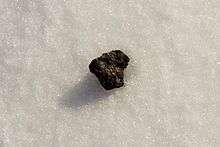
The United States space agency NASA estimated the diameter of the bolide at about 17–20 m and has revised the mass several times from an initial 7,700 tonnes (7,600 long tons; 8,500 short tons),[13] until reaching a final estimate of 10,000 tonnes,[13][37][38][39][40] (11,000 short tons, greater than the total weight of the Eiffel Tower).[1][41] The air burst's blast wave, when it hit the ground, produced a seismic wave which registered on seismographs at magnitude 2.7.[42][43][44]
The Russian Geographical Society said the passing of the meteor over Chelyabinsk caused three blasts of different energy. The first explosion was the most powerful, and was preceded by a bright flash, which lasted about five seconds. Initial newspaper altitude estimates ranged from 30–70 km, with an explosive equivalent, according to NASA, of roughly 500 kilotonnes of TNT (2,100 TJ), although there is some debate on this yield.[45][46] (500 kt is exactly the same energy released by the Ivy King nuclear explosion in 1952). According to a paper in 2013, all these ~500 kiloton yield estimates for the meteor airburst are "uncertain by a factor of two because of a lack of calibration data at those high energies and altitudes."[7][8]
The hypocentre of the explosion was to the south of Chelyabinsk, in Yemanzhelinsk and Yuzhnouralsk. Due to the height of the air burst, the atmosphere absorbed most of the explosion's energy.[47][48] The explosion's blast wave first reached Chelyabinsk and environs between less than 2 minutes 23 seconds[49] and 2 minutes 57 seconds later.[50] The object did not release all of its kinetic energy in the form of a blast wave as some 90 kilotons of TNT (about 3.75 x 1014 joules, or 0.375 PJ) of the total energy of the main airburst's fireball was emitted as visible light according to NASA's Jet Propulsion Laboratory,[1][51] and two main fragments survived the primary airburst disruption at 29.7 kilometres (18.5 mi); they flared around 24 kilometres (15 mi), with one falling apart at 18.5 kilometres (11.5 mi) and the other remaining luminous down to 13.6 km,[8] with part of the meteoroid continuing on its general trajectory to punch a hole in the frozen Lake Chebarkul, an impact that was fortuitously captured on camera and released in November 2013.[52][53]
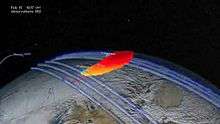
The infrasound waves given off by the explosions were detected by 20 monitoring stations designed to detect nuclear weapons testing run by the Comprehensive Test Ban Treaty Organization (CTBTO) Preparatory Commission, including the distant Antarctic station, some 15,000 kilometres (9,300 mi) away. The blast of the explosion was large enough to generate infrasound returns, after circling the globe, at distances up to about 85,000 kilometres (53,000 mi). Multiple arrivals involving waves that travelled twice around the globe have been identified. The meteor explosion produced the largest infrasounds ever to be recorded by the CTBTO infrasound monitoring system, which began recording in 2001,[55][56][57] so great that they reverberated around the world several times, taking over a day to dissipate.[58] Additional scientific analysis of US military infrasound data was aided by an agreement reached with US authorities to allow its use by civilian scientists, implemented only about a month before the Chelyabinsk meteor event.[17][58]

A preliminary estimate of the explosive energy by Astronomer Boris Shustov, director of the Russian Academy of Sciences Institute of Astronomy, was 200 kilotonnes of TNT (840 TJ),[59] another using empirical period-yield scaling relations and the infrasound records, by Peter Brown of the University of Western Ontario gave a value of 460–470 kilotonnes of TNT (1,900–2,000 TJ) and represents a best estimate for the yield of this airburst; there remains a potential "uncertainty [in the order of] a factor of two in this yield value".[60][61] Brown and his colleagues also went on to publish a paper in November 2013 which stated that the "widely referenced technique of estimating airburst damage does not reproduce the [Chelyabinsk] observations, and that the mathematical relations found in the book The Effects of Nuclear Weapons which are based on the Effects of nuclear weapons—[which is] almost always used with this technique—overestimate blast damage[when applied to meteor airbursts].[62] A similar overestimate of the explosive yield of the Tunguska airburst also exists; as incoming celestial objects have rapid directional motion, the object causes stronger blast wave and thermal radiation pulses at the ground surface than would be predicted by a stationary object exploding, limited to the height at which the blast was initiated-where the object's "momentum is ignored".[63] Thus a meteor airburst of a given energy is "much more damaging than an equivalent [energy] nuclear explosion at the same altitude."[64][65] The seismic wave produced when the primary airburst's blast struck the ground yields a rather uncertain "best estimate" of 430 kilotons(momentum ignored).[65] Corresponding to the seismic wave which registered on seismographs at magnitude 2.7.[42][43][44]

Brown also states that the double smoke plume formation, as seen in photographs, is believed to have coincided near the primary airburst section of the dust trail (as also pictured following the Tagish Lake fireball), and it likely indicates where rising air quickly flowed into the centre of the trail, essentially in the same manner as a moving 3D version of a mushroom cloud.[66] Photographs of this smoke trail portion, prior to it splitting into two plumes, depict this cigar shaped region glowing incandescently for a few seconds.[67] This region is the area in which the maximum of material ablation occurred, with the double plume persisting for a time and then appearing to rejoin or close up.[68]
Injuries and damage
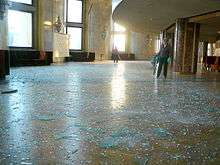
The blast created by the meteor's air burst produced extensive ground damage over an irregular elliptical area a few tens of kilometres across,[69] with the secondary effects of the blast being the main cause of the considerable number of injuries. Russian authorities stated that 1,491 people, including 311 children, sought medical attention in Chelyabinsk Oblast within the first few days.[3] Health officials said 112 people had been hospitalised, with two in serious condition. A 52-year-old woman with a broken spine was flown to Moscow for treatment.[23] Most of the injured were hurt by the secondary blast effects of shattered, falling or blown-in glass.[23][70] The intense light from the meteor, momentarily 30 times brighter than the Sun,[46] also produced injuries, leading to over 180 cases of eye pain, and 70 people subsequently reported temporary flash blindness.[71] Twenty people reported ultraviolet burns similar to sunburn, possibly intensified by the presence of snow on the ground.[71] Vladimir Petrov, when meeting with scientists to assess the damage, reported that he sustained so much sunburn from the meteor that the skin flaked only days later.[72]
A fourth-grade teacher in Chelyabinsk, Yulia Karbysheva, was hailed as a hero after saving 44 children from imploding window glass cuts. Despite not knowing the origin of the intense flash of light, Karbysheva thought it prudent to take precautionary measures by ordering her students to stay away from the room's windows and to perform a duck and cover maneuver. Karbysheva, who remained standing, was seriously lacerated when the blast arrived and window glass severed a tendon in one of her arms; none of her students, whom she ordered to hide under their desks, suffered cuts.[73]

After the air blast, car alarms went off and mobile phone networks were overloaded with calls.[74] Office buildings in Chelyabinsk were evacuated. Classes for all Chelyabinsk schools were cancelled, mainly due to broken windows.[23] At least 20 children were injured when the windows of a school and kindergarten were blown in at 09:22.[75] Following the event, government officials in Chelyabinsk asked parents to take their children home from schools.[76]
Approximately 600 m2 (6,500 sq ft) of a roof at a zinc factory collapsed during the incident.[77] Residents in Chelyabinsk whose windows were smashed quickly sought to cover the openings with anything available, to protect themselves against temperatures of −15 °C (5 °F).[78] Approximately 100,000 home-owners were affected, according to Chelyabinsk Oblast Governor Mikhail Yurevich.[79] He also said that preserving the water pipes of the city's district heating was the primary goal of the authorities as they scrambled to contain further post-explosion damage.[23]
By 5 March 2013 the number of damaged buildings was tallied at over 7,200, which included some 6,040 apartment blocks, 293 medical facilities, 718 schools and universities, 100 cultural organizations, and 43 sport facilities, of which only about one and a half percent had not yet been repaired.[4] The oblast's governor estimated the damage to buildings at more than 1 billion rubles[80] (approximately US$33 million). Chelyabinsk authorities said that broken windows of apartment homes, but not the glazing of enclosed balconies, would be replaced at the state's expense.[81] One of the buildings damaged in the blast was the Traktor Sport Palace, home arena of Traktor Chelyabinsk of the Kontinental Hockey League (KHL). The arena was closed for inspection, affecting various scheduled events, and possibly the postseason of the KHL.[82]
The irregular elliptical disk shape/"spread-eagled butterfly"[83] ground blast damage area, produced by the airburst,[84] is a phenomenon first noticed upon studying the other larger airburst event-Tunguska.[85]
Reactions
The Chelyabinsk meteor struck without warning, and the spectacle from two extraterrestrial object encounters within hours of each other led one Russian politician to publicly allege that the supposed meteor was actually "the test of a new weapon by the Americans",[86] an allegation quickly dismissed by Russian sources.
Dmitry Medvedev, the Prime Minister of Russia, confirmed a meteor had struck Russia and said it proves the "entire planet" is vulnerable to meteors and a spaceguard system is needed to protect the planet from similar objects in the future.[18][87] Dmitry Rogozin, the deputy prime minister, proposed that there should be an international program that would alert countries to "objects of an extraterrestrial origin",[88] also called potentially hazardous objects.
Colonel General Nikolay Bogdanov, commander of the Central Military District, created task forces that were directed to the probable impact areas to search for fragments of the asteroid and to monitor the situation. Meteorites (fragments) measuring 1 to 5 cm (0.39 to 1.97 in) were found 1 km (0.62 mi) from Chebarkul in the Chelyabinsk region.[89]
On the day of the impact, Bloomberg News reported that the United Nations Office for Outer Space Affairs had suggested the investigation of creating an "Action Team on Near-Earth Objects", a proposed global asteroid warning network system, in face of 2012 DA14's approach.[90][91] As a result of the impact, two scientists in California proposed directed-energy weapon technology development as a possible means to protect Earth from asteroids.[92][93]
Frequency
It is estimated that the frequency of airbursts from objects 20 metres across is about once in every 60 years.[94] There have been three incidents in the previous century involving a comparable energy yield or higher: the 1908 Tunguska event, the 1930 Curuçá River event, and in 1963 off the coast of Prince Edward Islands in the Indian Ocean. Two of those were over unpopulated areas, but the 1490 Ch'ing-yang event with an unknown magnitude apparently caused 10,000 deaths.[95] While modern researchers are skeptical about the figure, the one over Tunguska could have devastated a highly populous district.[95]
Origin
The meteor originated from the asteroid belt between Mars and Jupiter as determined by its entry speed of 19 kilometres/second. The Chelyabinsk meteor was probably a fragmented asteroid. The meteor had veins of black material which had experienced high-pressure shock and was partly melted, due to a previous collision. The metamorphism in the chondrules in the meteorite samples indicates the meteor had been several kilometres below the surface of an LL-chondrite and had a history of collisions. The meteor was probably in a gravitational resonance in the asteroid belt which increased the eccentricity of the orbit until the meteor collided into the Earth.[96]
Meteorites

In the aftermath of the air burst of the body, a large number of small meteorites fell on areas west of Chelyabinsk, generally at terminal velocity, about the speed of a piece of gravel dropped from a skyscraper.[97] Analysis of the meteor showed that all resulted from the main breakup at 27–34 km altitude.[7] Local residents and schoolchildren located and picked up some of the meteorites, many located in snowdrifts, by following a visible hole that had been left in the outer surface of the snow. Speculators were active in the informal market that emerged for meteorite fragments.[97]
In the hours following the visual meteor sighting, a 6-metre (20 ft) wide hole was discovered on Lake Chebarkul's frozen surface. It was not immediately clear whether this was the result of an impact; scientists from the Ural Federal University collected 53 samples from around the hole the same day it was discovered. The early specimens recovered were all under 1 centimetre (0.39 in) in size and initial laboratory analysis confirmed their meteoric origin. They are ordinary chondrite meteorites and contain 10% iron. The fall is officially designated as the Chelyabinsk meteorite.[2] The Chelyabinsk meteor was later determined to come from the LL chondrite group.[98] The meteorites were LL5 chondrites having a shock stage of S4, and had a variable appearance between light and dark types. Petrographic changes during the fall allowed estimates that the body was heated between 65 and 135 degrees during its atmospheric entry.[99]
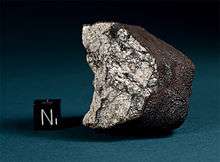
In June 2013, Russian scientists reported that further investigation by magnetic imaging below the location of the ice hole in Lake Chebarkul had identified a 60-centimetre (2.0 ft)-size meteorite buried in the mud at the bottom of the lake. Before recovery began, the chunk was estimated to weigh roughly 300 kilograms (660 lb).[100]
Following an operation lasting a number of weeks, it was raised from the bottom of the Chebarkul lake on 16 October 2013. With a total mass of 654 kg (1,442 lb) this is the largest found fragment of the Chelyabinsk meteorite. Initially, it tipped and broke the scales used to weigh it, splitting into three pieces.[101][102]
In November 2013, a video from a security camera was released showing the impact of the fragment at the Chebarkul lake.[7][103] This is the first recorded impact of a meteorite on video. From the measured time difference between the shadow generating meteor to the moment of impact, scientists calculated that this meteorite hit the ice at about 225 metres per second, 64 percent of the speed of sound.[7]
Media coverage
The Russian government put out a brief statement within an hour of the event. Heavy coverage by the international media had begun by the time the Associated Press put out a brief report with the Russian government's confirmation less than two hours afterwards.[104][105] Less than 15 hours after the meteor impact, videos of the meteor and its aftermath had been viewed millions of times.[106]
The number of injuries caused by the asteroid led the Internet-search giant Google to remove a Google Doodle from their website, created for the predicted pending arrival of another asteroid, 2012 DA14.[107] New York City planetarium director Neil deGrasse Tyson stated the Chelyabinsk meteor was unpredicted because no attempt had been made to find and catalogue every 15-metre near-Earth object.[108] In television media interviews shortly afterwards Tyson also noted the disturbing closeness of the two completely unrelated events.
On 27 March 2013 a broadcast episode of NOVA titled "Meteor Strike" documented the Chelyabinsk meteor, including the large amounts of meteoritic science revealed by the numerous videos of the airburst posted online by ordinary citizens. The NOVA program called the video documentation and the related scientific discoveries of the airburst "unprecedented". The documentary also discussed the much greater tragedy "that could have been" had the asteroid entered the Earth's atmosphere more steeply.[58][109]
Impactor orbital parameters
| Source | Q | q | a | e | i | Ω | ω |
|---|---|---|---|---|---|---|---|
| AU | (°) | ||||||
| Popova, Jenniskens, Emel'yanenko et al.; Science[7] | 2.78 ±0.20 |
0.74 ±0.02 |
1.76 ±0.16 |
0.58 ±0.02 |
4.93 ±0.48° |
326.442 ±0.003° |
108.3 ±3.8° |
| Lyytinen via Hankey; AMS[110] | 2.53 | 0.80 | 1.66 | 0.52 | 4.05° | 326.43° | 116.0° |
| Zuluaga, Ferrin; arXiv[111] | 2.64 | 0.82 | 1.73 | 0.51 | 3.45° | 326.70° | 120.6° |
| Borovicka, et al.; IAU[112] | 2.33 | 0.77 | 1.55 | 0.50 | 3.6° | 326.41° | 109.7° |
| Zuluaga, Ferrin, Geens; arXiv[113] | 1.816 | 0.716 | 1.26 ± 0.05 |
0.44 ± 0.03 |
2.984° | 326.5° ± 0.3° |
95.5° ± 2° |
| Chodas, Chesley; JPL via Sky and Telescope[114] | 2.78 | 0.75 | 1.73 | 0.57 | 4.2° | ||
| Insan[115] | 1.5 | 0.5 | 3° | ||||
| Proud; GRL[116] | 2.23 | 0.71 | 1.47 | 0.52 | 4.61° | 326.53° | 96.58° |
| de la Fuente Marcos; MNRAS: Letters[117] | 2.48 | 0.76 | 1.62 | 0.53 | 3.97° | 326.45° | 109.71° |
Ω = Ascending node longitude, ω = Argument of perihelion
Multiple videos of the Chelyabinsk superbolide, particularly from dashboard cameras and traffic cameras, helped to establish the meteor's provenance as an Apollo asteroid.[112][118] Sophisticated analysis techniques included the subsequent superposition of nighttime starfield views over recorded daytime images, as well as the plotting of the daytime shadow vectors shown in several online videos.[58]
The radiant of the impacting asteroid was located in the constellation Pegasus in the Northern hemisphere.[111] The radiant was close to the Eastern horizon where the Sun was starting to rise.[111]
The asteroid belonged to the Apollo group of near-Earth asteroids,[111][119] and was roughly 40 days past perihelion[110] (closest approach to the Sun) and had aphelion (furthest distance from the Sun) in the asteroid belt.[110][111] Several groups independently derived similar orbits for the object, but with sufficient variance to point to different potential parent bodies of this meteoroid.[116][117][120] The Apollo asteroid 2011 EO40 is one of the candidates proposed for the role of the parent body of the Chelyabinsk superbolide.[117] Other published orbits are similar to the 2-kilometre-diameter asteroid (86039) 1999 NC43 to suggest they had once been part of the same object;[121] they may not be able to reproduce the timing of the impact.[117]
Coincidental asteroid approach

Preliminary calculations rapidly showed the object was unrelated to the long-predicted close approach on 15 February of what was at the time known as asteroid 2012 DA14 (later named 367943 Duende) that flew by Earth 16 hours later at a distance of 27,700 km.[13][122][123] The Sodankylä Geophysical Observatory,[32] Russian sources,[124] the European Space Agency,[125] NASA[13] and the Royal Astronomical Society[126] all indicated the two objects could not have been related because the two asteroids had widely different trajectories.
See also
Notes
- ↑ Historical, normally accurate, Chinese records of the 1490 Ch'ing-yang event describe over 10,000 deaths, but have never been confirmed.
References
- 1 2 3 4 5 Yeomans, Don; Chodas, Paul (1 March 2013). "Additional Details on the Large Fireball Event over Russia on Feb. 15, 2013". NASA/JPL Near-Earth Object Program Office. Archived from the original on 2013-04-30.
Note that [the] estimates of total energy, diameter and mass are very approximate.
NASA's webpage in turn acknowledges credit for its data and visual diagrams to:- Peter Brown (University of Western Ontario); William Cooke (Marshall Space Flight Center); Paul Chodas, Steve Chesley and Ron Baalke (JPL); Richard Binzel (MIT); and Dan Adamo.
- 1 2 "Chelyabinsk". Meteoritical Bulletin Database. The Meteoritical Society. Archived from the original on 2013-06-03.
- 1 2 Число пострадавших при падении метеорита приблизилось к 1500 [The number of victims of the meteorite approached 1500] (in Russian). РосБизнесКонсалтинг [RBC]. 18 February 2013. Archived from the original on 2013-05-02.
- 1 2 "Meteorite-caused emergency situation regime over in Chelyabinsk region". Russia Beyond The Headlines. Rossiyskaya Gazeta. Interfax. 5 March 2013.
- 1 2 Atkinson, Nancy (15 February 2013). "Airburst Explained: NASA Addresses the Russian Meteor Explosion". Universe Today. Archived from the original on 2013-02-17.
- ↑ "O. P. Popova,et al. Chelyabinsk Airburst, Damage Assessment, Meteorite Recovery and Characterization.Science 342 (2013)." (PDF).
- 1 2 3 4 5 6 7 8 9 10 Popova, Olga P.; Jenniskens, Peter; Emel'yanenko, Vacheslav; et al. (2013). "Chelyabinsk Airburst, Damage Assessment, Meteorite Recovery, and Characterization". Science. 342 (6162): 1069–1073. Bibcode:2013Sci...342.1069P. doi:10.1126/science.1242642. Archived from the original on 2014-01-25.
- 1 2 3 4 5 6 7 "O. P. Popova, et al. Chelyabinsk Airburst, Damage Assessment, Meteorite Recovery and Characterization.Science 342 (2013)." (PDF).
- ↑ Schiermeier, Quirin (6 November 2013). "Risk of massive asteroid strike underestimated". Nature News. Nature Publishing Group. Archived from the original on 2013-11-07.
- ↑ Byford, Sam (15 February 2013). "Russia rocked by meteor explosion". The Verge. Archived from the original on 2013-03-05.
- 1 2 Kuzmin, Andrey (15 February 2013). "Meteorite explodes over Russia, more than 1,000 injured". Reuters. Archived from the original on 2013-02-22.
- ↑ Shurmina, Natalia; Kuzmin, Andrey (15 February 2013). "Meteorite hits central Russia, more than 500 people hurt". Yahoo News. Archived from the original on 2013-02-15.
- 1 2 3 4 5 Agle, D. C. (13 February 2013). "Russia Meteor Not Linked to Asteroid Flyby". NASA news. NASA. Archived from the original on 2013-02-17.
- ↑ Arutunyan, Anna; Bennetts, Marc (15 February 2013). "Meteor in central Russia injures at least 500". USA Today.
- ↑ Heintz, Jim; Isachenkov, Vladimir (15 February 2013). "100 injured by meteorite falls in Russian Urals". Mercury News. Associated Press. Archived from the original on 2013-05-02.
- 1 2 Major, Jason (15 February 2013). "Meteor Blast Rocks Russia". Universe Today. Archived from the original on 2013-02-17.
- 1 2 Fountain, Henry (25 March 2013). "A Clearer View of the Space Bullet That Grazed Russia". New York Times. Archived from the original on 2013-03-26.
- 1 2 "PM Medvedev Says Russian Meteorite KEF-2013 Shows "Entire Planet" Vulnerable". Newsroom America. 15 February 2013. Archived from the original on 2013-06-23.
- ↑ Videos capture exploding meteor in sky (Television production). United States: CNN. 16 February 2013.
- ↑ "Meteor shower over Russia sees meteorites hit Earth". The Sydney Morning Herald. 16 February 2013. Archived from the original on 2013-06-23.
- ↑ "Russian Meteor strike eyewitnesses speak". YouTube. 15 February 2013.
In Russian, with translation voiceover in English
- ↑ Mackey, Robert; Mullany, Gerry (15 February 2013). "Spectacular Videos of Meteor Over Siberia". New York Times. Archived from the original on 2013-04-30.
- 1 2 3 4 5 6 7 "Meteorite hits Russian Urals: Fireball explosion wreaks havoc, up to 1,200 injured (PHOTOS, VIDEO)". RT. 15 February 2013. Archived from the original on 2013-02-22.
- ↑ Rubin, Alan E.; Grossman, Jeffrey N. (January 2010). "Meteorite and meteoroid: New comprehensive definitions". Meteoritics & Planetary Science. 45 (1): 114–122. Bibcode:2010M&PS...45..114R. doi:10.1111/j.1945-5100.2009.01009.x.
- ↑ Grady, Monica M (31 August 2000). Catalogue of Meteorites. London: Natural History Museum, Cambridge University Press. p. 285. ISBN 978-0-521-66303-8.
- ↑ Brumfiel, Geoff (15 February 2013). "Russian meteor largest in a century". Nature. doi:10.1038/nature.2013.12438. Archived from the original on 2013-02-20.
- ↑ T.C. (15 February 2013). "Asteroid impacts – How to avert Armageddon". The Economist. Archived from the original on 2013-02-19.
- ↑ Chang, Kenneth (15 February 2013). "Size of Blast and Number of Injuries Are Seen as Rare for a Rock From Space". New York Times. Archived from the original on 2013-02-20.
- ↑ Ewalt, David M (15 February 2013). "Exploding Meteorite Injures A Thousand People in Russia". Forbes. Archived from the original on 2013-04-08.
- ↑ S.F. Chronicle (1896). "Explosion of an Aerolite in Madrid (10 February 1896)". Notices from the Lick Observatory. Publications of the Astronomical Society of the Pacific. 8 (47): 86–87. Bibcode:1896PASP....8...86C. doi:10.1086/121074.
Many injuries resulted from the panic which broke out... Much damage was done by the force of the concussion.
- ↑ Heintz, Jim (15 February 2013). "500 injured by blasts as meteor falls in Russia". Yahoo News. Archived from the original on 2013-06-24.
- 1 2 "Are 2012 DA14 and the Chelyabinsk meteor related?". Kilpisjärvi Atmospheric Imaging Receiver Array. Finland: Sodankylä Geophysical Observatory. 15 February 2013. Archived from the original on 23 June 2013.
- ↑ Barstein, Geir (18 February 2013). "Kan koste flere tusen grammet" [(Meteorite) can cost several thousand dollars per gram]. Dagbladet (in Norwegian). Archived from the original on 2013-05-01.
- ↑ ssvilponis (16 February 2013). Chelyabinsk meteorite, 2013 February 15th (Map). Google Maps.
- ↑ Geens, Stefan (16 February 2013). "Reconstructing the Chelyabinsk meteor's path, with Google Earth, YouTube and high-school math". Ogle Earth. Archived from the original on 2013-02-28.
- ↑ Fazekas, Andrew (1 July 2013). "Russian Meteor Shockwave Circled Globe Twice". Newswatch. National Geographic Society. Archived from the original on 2013-07-13.
- ↑ Cooke, William (15 February 2013). "Orbit of the Russian Meteor". NASA blogs. Archived from the original on 2013-03-07.
- ↑ Malik, Tariq (17 February 2013). "Russian Meteor Blast Bigger Than Thought, NASA Says". Huffington Post. Archived from the original on 2013-02-18.
- ↑ Black, Phil; Smith-Spark, Laura (18 February 2013). "Russia starts cleanup after meteor strike". CNN. Archived from the original on 2013-02-17.
- ↑ Sreeja, VN (4 March 2013). "New Asteroid '2013 EC' Similar To Russian Meteor To Pass Earth At A Distance Less Than Moon's Orbit". International Business Times. Archived from the original on 2013-04-30.
- ↑ "All you need to know about the Eiffel Tower" (PDF). www.tour-eiffel.fr. Paris: Société d'Exploitation de la Tour Eiffel. Archived (PDF) from the original on 2013-06-23.
- 1 2 "Meteor Explosion near Chelyabinsk, Russia". US Geological Survey. 15 February 2013. Archived from the original on 2013-02-19.
- 1 2 "Magnitude ? (Uncertain Or Not Yet Determined) – URAL MOUNTAINS REGION, RUSSIA". National Earthquake Information Center. U.S. Geological Survey. 15 February 2013. Archived from the original on 18 February 2013.
- 1 2 Oskin, Becky (15 February 2013). "Russia meteor blast produced 2.7 magnitude earthquake equivalent". Christian Science Monitor. ISSN 0882-7729. Archived from the original on 2013-02-16.
- ↑ "Russian meteorite blast explained: Fireball explosion equal to 20 Hiroshimas". RT. 15 February 2013. Archived from the original on 2013-02-16.
- 1 2 Sample, Ian (7 November 2013). "Scientists reveal the full power of the Chelyabinsk meteor explosion". The Guardian. Archived from the original on 2013-11-09.
- ↑ "Meteor threat wasn't expected for another 2,000 years – Russian Emergency Minister". RT. 22 February 2013. Archived from the original on 2013-02-25.
- ↑ "Russian meteor hit atmosphere with force of 30 Hiroshima bombs". The Telegraph. 16 February 2013. Archived from the original on 2013-02-18.
- ↑ "Meteorite flash and Shock wave from the asteroid at the University of Chelyabinsk CCTV Footage". LiveLeak. 19 February 2013. Archived from the original on 2013-05-07.
Datestamped CCTV footage starts at 2:38
- ↑ Метеорит в Челябинске [Meteorite in Chelyabinsk] (in Russian). YouTube. 15 February 2013.
- ↑ Brown, P.; Spalding, R. E.; ReVelle, D. O.; Tagliaferri, E.; Worden, S. P. (2002). "The flux of small near-Earth objects colliding with the Earth" (PDF). Nature. 420 (6913): 294–296. Bibcode:2002Natur.420..294B. doi:10.1038/nature01238. PMID 12447433. Archived (PDF) from the original on 2013-04-30.
- ↑ "Newly Released Security Cam Video Shows Chelyabinsk Meteorite Impact in Lake Chebarkul by Bob King on November 7, 2013".
- ↑ "Huge half-ton chunk of Russian meteorite lifted from lakebed". 16 October 2013. Retrieved 13 November 2013.
- ↑ "Fallout from the Russian fireball encircled Earth, research shows".
- ↑ "Russian Fireball Largest Ever Detected by CTBTO's Sensors". CTBTO. 18 February 2013.
- ↑ Harper, Paul (20 February 2013). "Meteor explosion largest infrasound recorded". The New Zealand Herald. APN Holdings NZ.
- ↑ Schiermeier, Quirin (10 June 2013). "Russian meteor blast was the largest ever recorded by CTBTO". Nature News Blog. Macmillan Publishers Limited.
- 1 2 3 4 "Meteor Strike". NOVA. PBS. 27 March 2013. Archived from the original on 2013-04-21.
- ↑ http://atominfo.ru/newsd/k0520.htm
- ↑ "Fireball Events Chelyabinsk Meteor of 15 Feb. 2013 - Preliminary results as of Feb 16, 2013. Dr. Peter Brown".
- ↑ Le Pichon, Alexis; Ceranna, L.; Pilger, C.; Mialle, P.; Brown, D.; Herry, P.; Brachet, N. (2013). "2013 Russian Fireball largest ever detected by CTBTO infrasound sensors". Geophysical Research Letters. 40 (14): 3732. Bibcode:2013GeoRL..40.3732L. doi:10.1002/grl.50619.
- ↑ "A 500-kiloton airburst over Chelyabinsk and an enhanced hazard from small impactors".
- ↑ "Sandia supercomputers offer new explanation of Tunguska disaster". Sandia National Laboratories. 2007-12-17. Retrieved 2007-12-22.
- ↑ "Research to Address Near-Earth Objects Remains Critical, Experts Say".
- 1 2 Kelly Beatty (November 7, 2013). "New Chelyabinsk Results Yield Surprises".
- ↑ "WGN, the Journal of the IMO 41:1 (2013) A Preliminary Report on the Chelyabinsk Fireball/Airburst Peter Brown" (PDF).
- ↑ "O. P. Popova, et al. Chelyabinsk Airburst, Damage Assessment, Meteorite Recovery and Characterization.Science 342 (2013). FIGURE 1" (PDF).
- ↑ "Postcards from Chelyabinsk - SETI Institute Colloquium Series (Peter Jenniskens) 15:10 on".
- ↑ "Map of glass damage in Chelyabinsk Oblast. From: Popova et al. Science Science Vol. 42 (2013).".
- ↑ Heintz, Jim; Isachenkov, Vladimir (15 February 2013). "Meteor explodes over Russia's Ural Mountains; 1,100 injured as shock wave blasts out windows". Postmedia Network Inc. The Associated Press. Archived from the original on 2013-05-13.
Emergency Situations Ministry spokesman Vladimir Purgin said many of the injured were cut as they flocked to windows to see what caused the intense flash of light, which was momentarily brighter than the sun.
- 1 2 Grossman, Lisa (6 November 2013). "CSI Chelyabinsk: 10 insights from Russia's meteorite". New Scientist. Archived from the original on 2013-11-09.
- ↑ http://cams.seti.org/index-chelyabinsk.html
- ↑ Kramer, Andrew E. (17 February 2013). "After Assault From the Heavens, Russians Search for Clues and Count Blessings". New York Times. Archived from the original on 2013-02-17.
- ↑ "Meteorite explosion over Russia injures hundreds". The Guardian. 15 February 2013. Archived from the original on 2013-02-18.
- ↑ Bidder, Benjamin (15 February 2013). "Meteoriten-Hagel in Russland: "Ein Knall, Splittern von Glas"" [Meteorite hail in Russia: "A blast, splinters of glass"]. Der Spiegel (in German). Archived from the original on 2013-02-18.
- ↑ "Central Russia hit by meteor shower in Ural region". BBC News. 15 February 2013. Archived from the original on 2013-02-18.
- ↑ Campbell, Charlie (15 February 2013). "Meteorite injures hundreds in Russia". Time. Archived from the original on 2013-02-15.
- ↑ "Chelyabinsk Station history". Weather Underground. 15 February 2013. Archived from the original on 2013-04-30.
- ↑ Zhang, Moran (16 February 2013). "Russia Meteor 2013: Damage To Top $33 Million; Rescue, Cleanup Team Heads To Meteorite-Hit Urals". International Business Times. Archived from the original on 2013-04-30.
- ↑ Ущерб от челябинского метеорита превысит миллиард рублей [Damage from Chelyabinsk meteorite exceeds one billion rubles] (in Russian). Lenta.ru. 15 February 2013. Archived from the original on 2013-05-13.
- ↑ Сергей Давыдов: жертв и серьезных разрушений нет [Sergei Davydov: casualties and no serious damage]. Chelad (in Russian). 15 February 2013. Archived from the original on 2013-02-17.
- ↑ Gretz, Adam (15 February 2013). "KHL arena among buildings damaged in Russian meteorite strike". CBS Sports. Archived from the original on 2013-05-01.
- ↑ "NASA and International Researchers Collect Clues to Meteoroid Science November 6, 2013".
- ↑ "Map of glass damage in Chelyabinsk Oblast. From: Popova et al. Science Science Vol. 42 (2013).".
- ↑ Boyarkina, A. P., Demin, D. V., Zotkin, I. T., Fast, W. G. Estimation of the blast wave of the Tunguska meteorite from the forest destruction. – Meteoritika, Vol. 24, 1964, pp. 112–128 (in Russian).
- ↑ "US tested new weapon, no meteor in Chelyabinsk – Russian LibDem leader". Russian International News Agency. Retrieved 15 February 2013.
- ↑ "400 injured by meteorite falls in Russian Urals". Y net news. 15 February 2013. Archived from the original on 2013-02-18.
- ↑ Amos, Howard (15 February 2013). "Meteorite explosion over Chelyabinsk injures hundreds". The Guardian. Archived from the original on 2013-02-18.
- ↑ В полынье в Чебаркульском районе Челябинской области, возможно, найдены обломки метеорита – МЧС [In the ice-hole in Chebarkulsky district of Chelyabinsk region, possibly found fragments of the meteorite - MOE] (in Russian). Interfax. 15 February 2013. Archived from the original on 2013-06-23.
- ↑ Drajem, Mark; Weber, Alexander (15 February 2013). "Asteroid Passes Earth as UN Mulls Monitoring Network". Bloomberg. Archived from the original on 2013-02-18.
- ↑ David, Leonard (18 February 2013). "United Nations reviewing asteroid impact threat". CBS News. Archived from the original on 2013-02-18.
- ↑ Villamarin, Jenalyn (22 February 2013). "End of the World 2013: DE-STAR Project Proposed after Asteroid 2012 DA14 Flyby, Russian Meteor Blast". International Business Times. Archived from the original on 2013-04-30.
- ↑ Barrie, Allison (19 February 2013). "Massive, orbital laser blaster could defend against asteroid threats". Fox News. Archived from the original on 2013-02-21.
- ↑ Robert Marcus; H. Jay Melosh; Gareth Collins (2010). "Earth Impact Effects Program". Imperial College London / Purdue University. Retrieved 2013-02-04. (solution using 2600kg/m^3, 17km/s, 45 degrees)
- 1 2 Yau, K., Weissman, P., & Yeomans, D. Meteorite Falls In China And Some Related Human Casualty Events, Meteoritics, Vol. 29, No. 6, pp. 864-871, ISSN 0026-1114, bibliographic code: 1994Metic..29..864Y.
- ↑ Kring, David A.; Boslough, Mark (2014-09-01). "Chelyabinsk: Portrait of an asteroid airburst". Physics Today. 67 (9): 32–37. doi:10.1063/PT.3.2515. ISSN 0031-9228.
- 1 2 Kramer, Andrew E. (18 February 2013). "Russians Wade Into the Snow to Seek Treasure From the Sky". New York Times.
- ↑ "NASA (YouTube) – Dr. David Kring – Asteroid Initiative Workshop Cosmic Explorations Speakers Session". YouTube. 21 November 2013.
- ↑ Badyukov, D.D.; Raitala, J.; Kostama, P.; Ignatiev, A.V. (March 2015). "Chelyabinsk meteorite: Shock metamorphism, black veins and impact melt dikes, and the Hugoniot". Petrology. 23 (2): 103–115. doi:10.1134/S0869591115020022.
- ↑ "Huge Chunk of Meteorite Located in Urals Lake - Scientist". RIA Novosti. 22 June 2013. Archived from the original on 2013-06-23.
- ↑ Весы не выдержали тяжести челябинского метеорита [Weighing scales couldn't withstand the heft of the Chelyabinsk meteorite] (in Russian). NTV. 16 October 2013. Archived from the original on 2013-10-17.
- ↑ Herszenhorn, David M. (16 October 2013). "Lifted From a Russian Lake, a Big, if Fragile, Space Rock". New York Times. Archived from the original on 2013-10-17.
- ↑ King, Bob (7 November 2013). "Newly Released Security Cam Video Shows Chelyabinsk Meteorite Impact in Lake Chebarkul". Universe Today. Archived from the original on 2013-11-09.
- ↑ Franke-Ruta, Garance (15 February 2013). "How a D.C. Hockey Fan Site Got the Russian Meteorite Story Before the AP". The Atlantic. Archived from the original on 2013-02-17.
- ↑ Челябинский метеорит стал одной из самых популярных тем в мире [Chelyabinsk meteorite has become one of the hottest topics in the world]. Federal Press World News (in Russian). Federal Press. 15 February 2013. Archived from the original on 2013-06-23.
- ↑ "Meteor Over Russia Hits Internet with 7.7 Million Video Views". Visible Measures. Visible Measures.
- ↑ Stern, Joanna (15 February 2013). "Asteroid 2012 DA14 Google Doodle Removed After Russian Meteor Shower Injuries". ABC News. Archived from the original on 16 February 2013.
- ↑ "Neil deGrasse Tyson: Radar could not detect meteor". Today. 15 February 2013. Archived from the original on 2015-05-25.
- ↑ Kaplan, Karen (27 March 2013). "Russian meteor, a 'death rock from space,' stars on 'Nova'". Los Angeles Times. Archived from the original on 2013-03-28.
- 1 2 3 Hankey, Mike (15 February 2013). "Large Daytime Fireball Hits Russia". American Meteor Society. Archived from the original on 2013-05-21.
- 1 2 3 4 5 Zuluaga, Jorge I.; Ferrin, Ignacio (2013). "A preliminary reconstruction of the orbit of the Chelyabinsk Meteoroid". arXiv:1302.5377
 [astro-ph.EP].
[astro-ph.EP]. We use this result to classify the meteoroid among the near Earth asteroid families finding that the parent body belonged to the Apollo asteroids.
- 1 2 "CBET 3423 : 20130223 : Trajectory and Orbit of the Chelyabinsk Superbolide". Astronomical Telegrams. International Astronomical Union. 23 February 2013. Archived from the original on 2013-04-23. (registration required)
- ↑ Zuluaga, Jorge I.; Ferrin, Ignacio; Geens, Stefan (2013). "The orbit of the Chelyabinsk event impactor as reconstructed from amateur and public footage". arXiv:1303.1796
 [astro-ph.EP].
[astro-ph.EP]. - ↑ Beatty, Kelly (6 March 2013). "Update on Russia's Mega-Meteor". Sky and Telescope. Sky Publishing Corp.
- ↑ Вибе, Дмитрий (25 March 2013). Семинар по Челябинскому метеориту: российская наука выдала "официальную" информацию [Seminar in Chelyabinsk meteorite: Russian science has given "official" information] (in Russian). Компьютерра [Computerra]. Archived from the original on 2013-06-23.
- 1 2 Proud, S. R. (16 July 2013). "Reconstructing the orbit of the Chelyabinsk meteor using satellite observations". Geophysical Research Letters. 40 (13): 3351–3355. Bibcode:2013GeoRL..40.3351P. doi:10.1002/grl.50660.
- 1 2 3 4 de la Fuente Marcos, C.; de la Fuente Marcos, R. (1 September 2014). "Reconstructing the Chelyabinsk event: pre-impact orbital evolution". Monthly Notices of the Royal Astronomical Society: Letters. 443 (1): L39–L43. arXiv:1405.7202
 . Bibcode:2014MNRAS.443L..39D. doi:10.1093/mnrasl/slu078.
. Bibcode:2014MNRAS.443L..39D. doi:10.1093/mnrasl/slu078. - ↑ "Astronomers Calculate Orbit of Chelyabinsk Meteorite". The Physics arXiv Blog. MIT Technology Review. 25 February 2013.
Their conclusion is that the Chelyabinsk meteorite is from a family of rocks that cross Earth’s orbit called Apollo asteroids.
- ↑ Rincon, Paul (26 February 2013). "Russia meteor's origin tracked down". BBC News. Archived from the original on 2013-02-26.
- ↑ Geens, Stefan (9 March 2013). "Chelyabinsk meteoroid trajectories compared using Google Earth and YouTube". YouTube.
- ↑ Borovička, Jiří; Spurný, Pavel; Brown, Peter; Wiegert, Paul; Kalenda, Pavel; Clark, David; Shrbený, Lukáš (6 November 2013). "The trajectory, structure and origin of the Chelyabinsk asteroidal impactor". Nature. Bibcode:2013Natur.503..235B. doi:10.1038/nature12671.
- ↑ Plait, Phil (15 February 2013). "Breaking: Huge Meteor Explodes Over Russia". Slate. Archived from the original on 2013-02-16.
- ↑ Уральский метеорит отвлек научный мир от знаменитого астероида [Ural meteorite distracted (sic) from the scientific world famous asteroid] (in Russian). Moscow: РИА Новости (RIA Novosti). 15 February 2013. Archived from the original on 2013-03-17.
- ↑ Elenin, Leonid (15 February 2013). "Siberian fireball (video)". SpaceObs (in Russian). Archived from the original on 2013-03-04.
- ↑ "Russian Asteroid Strike". ESA.int. European Space Agency. 15 February 2013. Archived from the original on 2013-02-21.
- ↑ Marson, James; Naik, Gautam (15 February 2013). "Falling Meteor Explodes Over Russia". The Wall Street Journal. Archived from the original on 2013-02-15.
- Attribution
- This article contains portions of text translated from the corresponding article of the Russian Wikipedia. A list of contributors can be found there in its history section.
Further reading
- Balcerak, E. (2013). "Nuclear test monitoring system detected meteor explosion over Russia". Eos, Transactions American Geophysical Union. 94 (42): 384. Bibcode:2013EOSTr..94S.384B. doi:10.1002/2013EO420010.
- Barry, Ellen; Kramer, Andrew E. (15 February 2013). "Shock Wave of Fireball Meteor Rattles Siberia, Injuring 1,200". NYTimes.com. (website).
Also published as "Meteor Explodes, Injuring Over 1,000 in Siberia". New York Times (New York ed.). 16 February 2013. p. A1. (print). - Borovička, J.; Spurný, P.; Brown, P.; Wiegert, P.; Kalenda, P.; Clark, D.; Shrbený, L. (2013). "The trajectory, structure and origin of the Chelyabinsk asteroidal impactor". Nature. 503 (7475): 235–237. Bibcode:2013Natur.503..235B. doi:10.1038/nature12671.
- Brown, P. G.; Assink, J. D.; Astiz, L.; Blaauw, R.; Boslough, M. B.; Borovička, J.; Brachet, N.; Brown, D.; Campbell-Brown, M.; Ceranna, L.; Cooke, W.; de Groot-Hedlin, C.; Drob, D. P.; Edwards, W.; Evers, L. G.; Garces, M.; Gill, J.; Hedlin, M.; Kingery, A.; Laske, G.; Le Pichon, A.; Mialle, P.; Moser, D. E.; Saffer, A.; Silber, E.; Smets, P.; Spalding, R. E.; Spurný, P.; Tagliaferri, E.; et al. (2013). "A 500-kiloton airburst over Chelyabinsk and an enhanced hazard from small impactors". Nature. 503 (7475): 238–241. Bibcode:2013Natur.503..238B. doi:10.1038/nature12741.
- Gorkavyi, N.; Rault, D. F.; Newman, P. A.; Da Silva, A. M.; Dudorov, A. E. (2013). "New stratospheric dust belt due to the Chelyabinsk bolide". Geophysical Research Letters. 40 (17): 4728–4733. Bibcode:2013GeoRL..40.4728G. doi:10.1002/grl.50788.
- Gorkavyi, N. N.; Taidakova, T. A.; Provornikova, E. A.; Gorkavyi, I. N.; Akhmetvaleev, M. M. (2013). "Aerosol plume after the Chelyabinsk bolide". Solar System Research. 47 (4): 275–279. Bibcode:2013SoSyR..47..275G. doi:10.1134/S003809461304014X.
- Kohout, Tomas; Gritsevich, Maria; Grokhovsky, Victor I.; Yakovlev, Grigoriy A.; Haloda, Jakub; Halodova, Patricie; Michallik, Radoslaw M.; Penttilä, Antti; Muinonen, Karri (2013). "Mineralogy, reflectance spectra, and physical properties of the Chelyabinsk LL5 chondrite – Insight into shock-induced changes in asteroid regoliths". Icarus. 228 (1): 78–85. arXiv:1309.6081
 . Bibcode:2014Icar..228...78K. doi:10.1016/j.icarus.2013.09.027.
. Bibcode:2014Icar..228...78K. doi:10.1016/j.icarus.2013.09.027. - Le Pichon, A.; Ceranna, L.; Pilger, C.; Mialle, P.; Brown, D.; Herry, P.; Brachet, N. (2013). "The 2013 Russian fireball largest ever detected by CTBTO infrasound sensors". Geophysical Research Letters. 40 (14): 3732–3737. Bibcode:2013GeoRL..40.3732L. doi:10.1002/grl.50619.
- Miller, Steven D.; Straka, William; Bachmeier, Scott (5 November 2013). "Earth-viewing satellite perspectives on the Chelyabinsk meteor event". Earth, Atmospheric, and Planetary Sciences. 110 (45): 18092–18097. Bibcode:2013PNAS..11018092M. doi:10.1073/pnas.1307965110.
- Popova, Olga P.; Jenniskens, Peter; Emel’yanenko, Vacheslav; Kartashova, Anna; Biryukov, Eugeny; Khaibrakhmanov, Sergey; Shuvalov, Valery; Rybnov, Yurij; Dudorov, Alexandr; Grokhovsky, Victor I.; Badyukov, Dmitry D.; Yin, Qing-Zhu; Gural, Peter S.; Albers, Jim; Granvik, Mikael; Evers, Läslo G.; Kuiper, Jacob; Kharlamov, Vladimir; Solovyov, Andrey; Rusakov, Yuri S.; Korotkiy, Stanislav; Serdyuk, Ilya; Korochantsev, Alexander V.; Larionov, Michail Yu.; Glazachev, Dmitry; Mayer, Alexander E.; Gisler, Galen; Gladkovsky, Sergei V.; Wimpenny, Josh; Sanborn, Matthew E.; Yamakawa, Akane; Verosub, Kenneth L.; Rowland, Douglas J.; Roeske, Sarah; Botto, Nicholas W.; Friedrich, Jon M.; Zolensky, Michael E.; Le, Loan; Ross, Daniel; Ziegler, Karen; Nakamura, Tomoki; Ahn, Insu; Lee, Jong Ik; Zhou, Qin; Li, Xian-Hua; Li, Qiu-Li; Liu, Yu; Tang, Guo-Qiang; Hiroi, Takahiro; Sears, Derek; Weinstein, Ilya A.; Vokhmintsev, Alexander S.; Ishchenko, Alexei V.; Schmitt-Kopplin, Phillipe; Hertkorn, Norbert; Nagao, Keisuke; Haba, Makiko K.; Komatsu, Mutsumi; Mikouchi, Takashi; (the Chelyabinsk Airburst Consortium) (2013). "Chelyabinsk Airburst, Damage Assessment, Meteorite Recovery, and Characterization". Science. 342 (6162): 1069–1073. Bibcode:2013Sci...342.1069P. doi:10.1126/science.1242642.
- Proud, S. R. (2013). "Reconstructing the orbit of the Chelyabinsk meteor using satellite observations". Geophysical Research Letters. 40 (13): 3351–3355. Bibcode:2013GeoRL..40.3351P. doi:10.1002/grl.50660.
- Tauzin, B.; Debayle, E.; Quantin, C.; Coltice, N. (2013). "Seismoacoustic coupling induced by the breakup of the 15 February 2013 Chelyabinsk meteor". Geophysical Research Letters. 40 (14): 3522. Bibcode:2013GeoRL..40.3522T. doi:10.1002/grl.50683.
- Yau, Kevin; Weissman, Paul; Yeomans, Donald (1994). "Meteorite falls in China and some related human casualty events". Meteoritics. 29 (6): 864–871. Bibcode:1994Metic..29..864Y. doi:10.1111/j.1945-5100.1994.tb01101.x. ISSN 0026-1114.
- Synopsis: "A calculation based on the number of casualty events in the Chinese meteorite records suggests that the probability of a meteorite striking a human is far greater than previous estimates."
External links
| Wikimedia Commons has media related to 2013 Russian meteor event. |
- "Meteor vapour trail from space". Image captured by EUMETSAT satellite.
- "Satellite views of meteor vapor trail over Russia". CIMSS Satellite Blog.
- Метеоритный удар по Челябинску [Collection of videos and photographs of the meteor and resulting damage]. Chelyabinsk website (in Russian).
- "The trajectory, structure and origin of the Chelyabinsk asteroidal impactor". Animations hosted by Paul Wiegert.
- "Postcards from Chelyabinsk - SETI Institute Colloquium Series (Peter Jenniskens) (video)". SETI institute.
- "Meteor Strike". NOVA documentary broadcast, 53 minutes, aired 27 March 2013. PBS.
Includes extensive scientific analysis of the worldwide infrasound monitoring network data from which the megaton energy estimates were made.
- Animation of meteor explosion, by "Strip the Cosmos"
